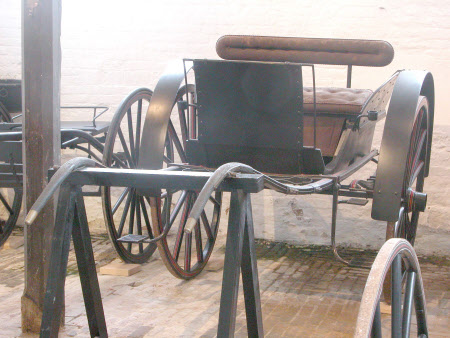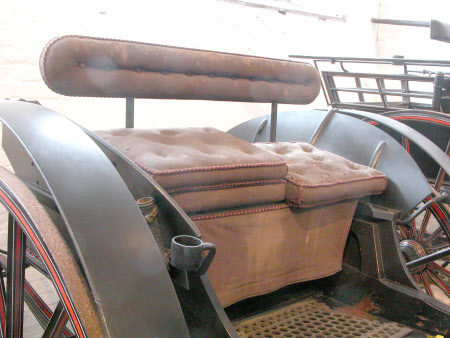Battlesden car
Bligh
Category
Carriages & other vehicles
Date
1870 - 1900
Materials
Painted wood body with wool cloth upholstery and two iron shod wheels.
Measurements
374 x 171.5 x 165cm (12ft 31/4in x 5ft 71.2in x 5ft 5in)
Place of origin
Canterbury
Order this imageCollection
Charlecote Park, Warwickshire
NT 534205
Caption
Battlesden cars were a useful carriage as they could seat four people back to back and, being lightweight, could be pulled by a pony or cob. This example was built by Bligh of Canterbury and painted in the Lucy family colours of brown/maroon and black with red and white lining.
Summary
Battlesden Car built by Bligh of Canterbury. Battlesden Car (two wheels) for a single horse. A Battlesden Car is a dog cart variant which is usually lower than most other variants and is identified by the characteristic curved lines of the body. The top of the body sides is a radial curve and the bent wood wings are practically semi-circular. Because of this curvilinear profile the dashboard, which is also wood, is also slightly curved. The relatively small wheels and low suspension make it necessary for the shafts to have more lift than most other dog cart variants. In this case the body is so low that a small arch is incorporated above the axle to avoid the possibility of the axle fouling the body when it was heavily loaded and possibly travelling over rough ground. Painted black with red and white lining.
Full description
A Battlesden Car is a useful sort of carriage as it can seat four people back to back. It is lightweight and has an unusual and eyecatching profile with the semi circular shaped wings over the wheels. The floor of this carriage is fairly low to the ground making it easy to get in and out of.
Provenance
Given to the National Trust in 1945.
Marks and inscriptions
On tailboard panel. : Family crest On nearside side panel.: Family Crest On offside side panel.: Family Crest On nearside axle cap.: BLIGH CANTERBURY On offside axle cap.: BLIGH CANTERBURY
Makers and roles
Bligh, coach builder
References
Carriage Driving, Feb - Mar 1998, pp.48-49

